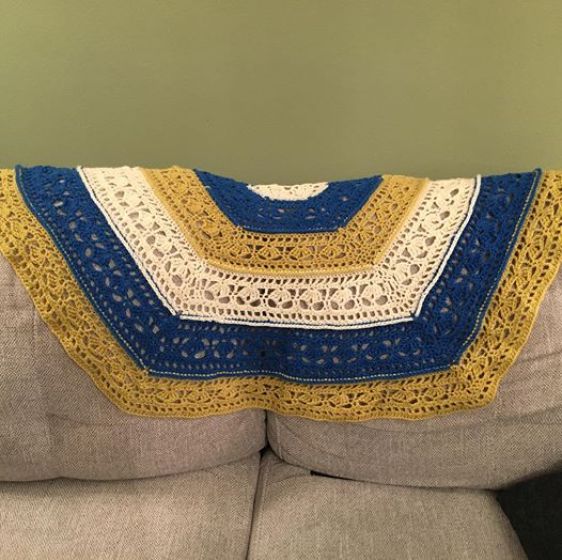Crochet Tips to Help You Get Started:
Master the Basic Stitches. When you start out, you may be inspired by crocheted items you see on Instagram or Pinterest. However, if you’re just starting out with no crochet experience, you should master your chaining as well as your single, double, and treble crochet stitches before you move on to full projects based on patterns. When I say “master,” though, I don’t mean your stitches must be absolutely perfect. Rather, make sure you produce consistent rows where all the stitches are about the same size. You don’t want several loose stitches in the same row as several tight stitches. You’ll need to practice to achieve that consistency, but you can do it!
Start With Simple Projects. When you start making projects, you should start with a patterns that repeats throughout the project and requires little to no shaping (garments like tops and skirts can require shaping). Often, crocheters’ first projects include scarves, potholders, and baby blankets. These are common first projects because they’re rectangular and they can be made with simple chaining and stitches. I encourage you to start with simple crafting projects because I know things like baking fail posts are popular online. While I think those posts are funny, I also worry that they discourage people from crafting by making it seem like the end result they wanted to achieve was impossible. Sometimes, those baking fails occur because the baker tried something beyond their skill level, or didn’t pay attention to the ingredients and equipment listed in the recipe. (I think that’s especially true for baking fails that involve cakes shaped like dinosaurs, Disney characters, or other complex-looking things). The same thing can be true for yarn-based crafts if you’re not careful. When you start out with simple projects, you can master the basic skills you’ll need when you tackle more complex projects in the future.
Pay Attention to Yarn Weight. Always use the type of yarn that a pattern calls for. The Craft Yarn Council has a list of yarn weight standards, and you should definitely use it. If your pattern calls for worsted-weight yarn, you’ll want to look for yarn with a 4 on it. If you need bulky/chunky yarn, look for a 5. DK is a 3, while sport-weight or fine yarn is a two. superfine or fingering weight yarn is a 1, and lace-weight yarn is a 0. You should make sure you use the weight listed in your pattern because using superfine yarn when the pattern calls for bulky yarn will result in a much smaller item when you finish it.
Pay Attention to Hook Size and Pattern Gauge. As with yarn weight, using a hook that is too large or too small can greatly affect the end product that you make. Gauge is related to hook size. Sometimes, you’ll have to change your hook size to get the right gauge, but not always. Gauge is how big or small the stitches are, and your gauge will vary from pattern to pattern. The pattern I’m using for my current project says its gauge should be “21 stitches & 11 rows in a pattern = 4” (10 cm) square. When I had enough rows and stitches to check the gauge, I measured them with my measuring tape, and those rows and stitches did make a 4″ (10 cm) square! I was so excited!
Don’t Be Afraid to Fail and Try Again. As you try something new, you will make mistakes. You may even fail as you cultivate a new skill or start a new project. That’s okay. It’s perfectly fine to fail. With crochet, you can always tear out your mistakes and start again. I’ve noticed that people around the world have read entries in this blog, so I’ll clarify that this point is mainly for my American readers. Americans tend to have a major fear of failure. We just cannot deal with it. It’s why the end of Infinity War was so traumatizing for us, and it’s also why Boston sportswriters flipped out when the St. Louis Blues beat the Boston Bruins in the 2019 Stanley Cup. For Americans, failure is not acceptable, partly because we tend to view everything the lens of sports. Failure means losing, and AMERICANS DO NOT LOSE! However, crafts such as crocheting and knitting give us a way to re-frame failure, not as “losing,” but as part of the creative process and as just another aspect of life. Take a look at this recent failure of mine:

This shawl has really pretty colors and really even rows and shells in it. So why is this shawl a failure? I pulled the yarn WAY too tight and I never checked my gauge, so it’s 20 inches too short for me to wear as a shawl. I’ll probably have to give it to one of my younger relatives, most likely one of my cousins’ children. However, instead of giving up crochet or getting really angry with myself, I decided to take the disappointment in stride and use this failure as a chance to learn to adjust my gauge from project to project. Since I started doing that, I’ve gotten over halfway through my next project:

This project is the size it needs to be, and I can match up the second half-hexagon I’m making to this completed one, so I know whether the second one is the right size. By trying again, I got the chance to make something else. So if you feel frustrated with your crocheting, take a moment to assess what you’re doing and think about how you could improve it. Sometimes, it’s takes a few tries to get something right. You can do it!